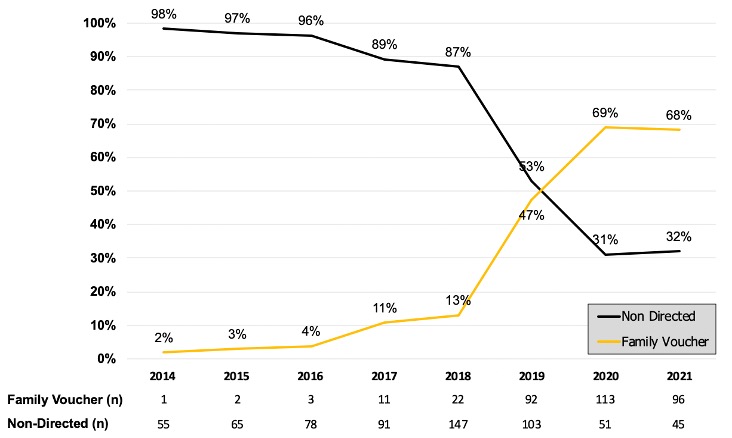Back
Poster, Podium & Video Sessions
Moderated Poster
MP36: Renal Transplantation & Vascular Surgery
MP36-04: The “Cannibalization” of Altruistic Kidney Donation by Voucher-based Kidney Transplantation
Sunday, May 15, 2022
7:00 AM – 8:15 AM
Location: Room 228
Nima Nassiri*, Torey Averick, Jeffrey Veale, Los Angeles, CA
- NN
Nima Nassiri, MD
Fellow
UCLA
Poster Presenter(s)
Introduction: Barriers to living kidney donation are multi-factorial, and may include logistic, financial, familial, cultural, and religious factors. Less discussed but impactful barriers involve: (1) a reluctance to donate because a present-day donation prohibits future one, and (2) chronological incompatibility. Voucher-based kidney donation seeks to address these latter two barriers. Herein, we sought to evaluate how voucher-based donations have impacted standard altruistic kidney donation.
Methods: Subjects were all patients participating in standard altruistic donation and voucher-based donation through the National Kidney Registry from 2014 to present. Demographic and clinical factors were considered. The impact on downstream chains of transplantation were also evaluated. Both voucher-based and standard altruistic donation were considered “non-directed”.
Results: Since 2014, the total number of non-directed donations, either from standard altruistic donation or through the voucher program, has risen by over 3-fold (Figure 1). The number standard altruistic donations has declined since 2018, coinciding with an uptick in the number of voucher-based donations from 22 in 2018 to 113 in 2020. Voucher-based donations continued to grow throughout the pandemic. The following trends have been seen: (1) a steady rise in FV-based donation from the inception of the voucher program to present; (2) a steady shift in the percent involvement from standard altruistic donation to voucher-based donation; and (3) an annual decline in number of standard altruistic donors over the past 3 years.
Conclusions: The following trends have been seen: (1) a steady rise in FV-based donation from the inception of the voucher program to present; (2) a steady shift in the percent involvement from standard altruistic donation to voucher-based donation; and (3) an annual decline in number of standard altruistic donors over the past 3 years. Though greater follow up is required, the short term trends suggest that voucher-based donation may be “cannibalizing” donation. Despite this, the overall number of non-directed donations, and the chains of transplants they spark, have expanded, delivering more high-quality kidneys and shortening the waiting time for kidney-paired exchange.
Source of Funding: OneLegacy Foundation

Methods: Subjects were all patients participating in standard altruistic donation and voucher-based donation through the National Kidney Registry from 2014 to present. Demographic and clinical factors were considered. The impact on downstream chains of transplantation were also evaluated. Both voucher-based and standard altruistic donation were considered “non-directed”.
Results: Since 2014, the total number of non-directed donations, either from standard altruistic donation or through the voucher program, has risen by over 3-fold (Figure 1). The number standard altruistic donations has declined since 2018, coinciding with an uptick in the number of voucher-based donations from 22 in 2018 to 113 in 2020. Voucher-based donations continued to grow throughout the pandemic. The following trends have been seen: (1) a steady rise in FV-based donation from the inception of the voucher program to present; (2) a steady shift in the percent involvement from standard altruistic donation to voucher-based donation; and (3) an annual decline in number of standard altruistic donors over the past 3 years.
Conclusions: The following trends have been seen: (1) a steady rise in FV-based donation from the inception of the voucher program to present; (2) a steady shift in the percent involvement from standard altruistic donation to voucher-based donation; and (3) an annual decline in number of standard altruistic donors over the past 3 years. Though greater follow up is required, the short term trends suggest that voucher-based donation may be “cannibalizing” donation. Despite this, the overall number of non-directed donations, and the chains of transplants they spark, have expanded, delivering more high-quality kidneys and shortening the waiting time for kidney-paired exchange.
Source of Funding: OneLegacy Foundation


.jpg)
.jpg)